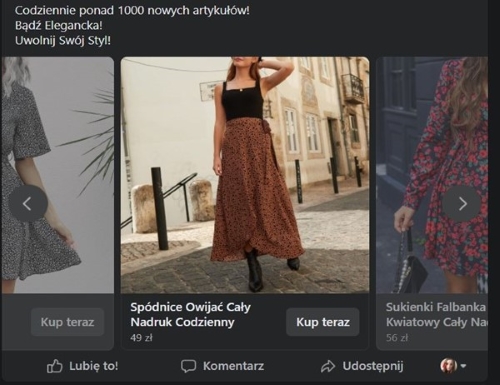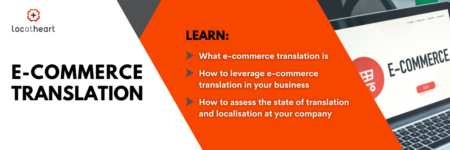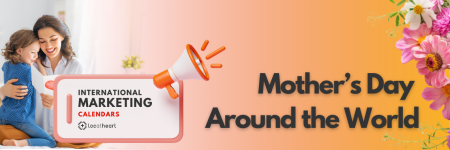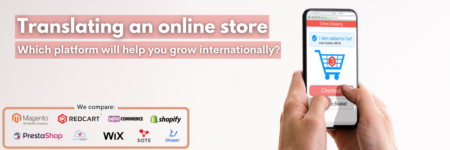How to create and translate Google Ads that convert?
Search engine ads – whether they are text or image based – are supposed to build and maintain a bond with a (potential) customer. Very often, they’re your recipient’s first exposure to the advertised brand. There’s little time to catch viewers’ attention, which is why both the original and the translated content of your ad should be well-thought-out and polished.
What will you learn from this entry?
- What makes up a search engine ad?
- How to plan and prepare an effective text ad with Google Ads?
- How do A/B tests work?
- What are RTMs and which display ads are posing as them?
- Is it worth localising every single ad?
- How not to translate SEM ads?
What are search engine ads?
SEM (search engine marketing) ad campaigns include SEO (search engine optimisation) practices and PPC (pay-per-click) advertisements that lead to your website. Google’s marketing campaigns are made up of text, display and product ads. They show up after you’ve entered a specific keyword or “accompany” you while you’re surfing the net.
You can read more about the effectiveness of SEM and SEO here.
For the purpose of this text, I will be focusing on Google Ads, as that’s the most-used search engine among European customers. However, when planning an expansion into new markets, you should always establish which search engine the customers prefer for their queries. Although it may seem like the American giant has taken over the whole world, that’s not exactly the case – for example, when it comes to South Korea, the undisputed leading player is Naver.
Preparing a text ad – course of action and good practices
Keyword analysis
The process of creating an ad campaign should always start with keyword analysis. At your disposal are such tools as the Google Keyword Planner and dedicated plug-ins or apps (e.g. Keyword Surfer, Senuto and Semrush). With their help, you can determine the most popular words typed into a search engine when your potential customers encounter a problem – a problem that your product or service is perfectly suited for! You’ll also find out which phrases it’s best to include when creating website content. At the same time, you’ll be able to do research on the keywords used by your competitors and prepare a more comprehensive and complex entry for the same query.
Text ad content
Google’s text ads consist of headings and their expanded descriptions. Each heading may consist of 30 characters in total, and each description – 90*. Now, what should you keep in mind when creating an ad?
- Include keywords but don’t lose the natural flow of the text.
- The landing page must fulfil the promises of the text ad.
- Keep the text coherent – both the ad and the content should speak with the same voice.
- Remember the character limit – go straight to the point and don’t use empty words.
- Place a CTA (call to action) to prompt a customer response.

With this ad concerning Korean cosmetics, the company wanted to share as much information (and as many benefits) as possible – about the free delivery conditions, returns and shipping. Those are the most notable online customer pain points. What’s missing from the ad? CTAs (e.g. “Click and see!”) and keywords (e.g. “Korean cosmetics” and the names of the most searched-for brands).
* It’s worth keeping up with Google updates regarding the character limit and the number of acceptable headings and descriptions.
Want to increase the reach and effectiveness of your ads? Test, test, and then test some more!
A/B tests are the best way to survey your target group’s taste and to maximally optimise the ads on the basis of those test results. Sometimes, the popularity of a given display ad may be decided by a small detail like a rounded CTA button. In the case of a text ad, it might be the wrong word order or verb choice.
When creating and localising advertisements, come up with a few different versions of the same content. You may experiment with:
- the graphics (e.g. an original project vs a stock photo);
- the graphic background (warm vs cool tones);
- the logo placement;
- the CTA button;
- the slogan (there are so many options – play with the form, register, vocabulary);
- the inclusion of certain elements (ascertain if the graphic without the slogan has a better visibility than the one with it).
When localising multiple versions of the same display ad, being aware of the subtleties of language is worth its weight in gold. In this case, expertise will prove invaluable.
Localising display ads – RTM and cultural references
RTM (real-time marketing) is essentially an ad campaign that references the current global events. The biggest advantage of this type of marketing is that it doesn’t need additional labour input – you simply make another display ad with an appropriate slogan, as you do with every other ad. There’s virtually no risk – you just publish the post/ad and wait: it will either be a hit or a miss. So, business as usual for a marketer, right?
The odds are that the RTM content will go viral. What does it mean in practice? The reach ultimately soars, the recipients are more willing to engage with the selected brand and share the content themselves, and sing the praises of your work.
Did you know that…
Many RTM campaigns can be anticipated and prepared in advance? All you need to do is monitor random holidays, choose the ones that apply to your target group and create appropriate content. Still, publications that you can plan are not really in line with real-time marketing. A true RTM campaign springs up in reaction to an unexpected event. That doesn’t change the fact that any reference to the current events has a huge chance to go viral. Don’t lose sight of your product or service, though. Every ad, even the boldest and most creative one, has to be related to your brand and your target group’s interests.
Examples of real and pretend RTM
- McDonald’s reacting to the self-destruction of Banksy’s painting:

RTM? Yes, both the auction winner and the rest of the world expected that Girl with Balloon would leave the Sotheby’s auction house in London in one piece.
- X-kom’s Brexit commentary.

RTM? No, because Brexit has been on everyone’s tongue for quite some time and x-kom (a computing products retailer from Poland) had enough time to plan and realise the above display ad. Nevertheless, the idea to connect the acronyms of gigabyte and Great Britain is really great and a memorable one.
Which ads are worth localising?
I can already tell you that not all of them. If you’re just introducing your product to a new market, it’s better to start building brand awareness and prepare an ad that presents your service – telling people what problems it solves, what needs it fulfils and what makes it stand out. A pre-established company mission and vision may be of great help – perhaps the organization’s philosophy itself is something worth putting in the spotlight?
Example: Ola Budzyńska, the founder and (self-proclaimed) Chief Gangstress of the brand Pani Swojego Czasu (eng. Mistress of Her Time) has had one goal from the very beginning – to help women organise and motivate them to chase their life goals and follow up on business ideas. She’s been consistently creating and reaching a very specific target group. Her course books, webinars and products revolve around the topics of planning your daily work and improving your talents. As a result, in the 7-year operation period, she has built an extremely engaged and devoted community. Her brand effectively uses the magic of words and catchy slogans to establish its character and uniqueness.
Protip: if you don’t know what to highlight, contact us – we’re happy to audit your brand, as well as companies of similar nature, and help you choose the appropriate course of action.
Which ads to leave alone?
Forget about transcreating culture-specific content. For instance, this yet another flawless Lidl ad (which, by the way, is the perfect example of RTM) will raise a smile from Polish recipients:

Some backstory will be necessary, though: a woman in Cracow called the local animal control authorities because she supposedly saw a wild, dangerous animal sitting in a tree. She described it as a “lagun,” butchering the word legwan, the Polish equivalent of iguana. Later on the mysterious beast turned out to be a croissant, and even though the story made world news, the probability that your customers also heard about it is very low.
This kind of advice also applies to any transcreation based on word play – if (un)translated, it loses its charm and style. Here is the incredibly clever commentary of the British postal service on the result of the Euro 2020 final match:

How not to translate?
Most importantly – don’t rely on machine translation (yes, that means all those readily available tools like Google Translate), hoping that “they won’t even notice, it’s just a typo.” Your one typo goes against hundreds of flawless and perfected text and display ads. You should always choose reliable companies with documented experience in translating, editing, and transcreating marketing content.

For example, the back-translation of this ad reads, “Dress Curl All Print Everyday.”
Unfortunately, the e-commerce world is getting more and more crowded, which is why brands have to compete for customer attention. That’s why you shouldn’t scrimp on advertisement budget. You need not only a well-thought-out business strategy, but also well-polished marketing content of various kinds – blog and social media posts, text and display ads, etc. We’re happy to walk you through the whole process. Contact us now!






Leave a Reply